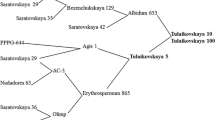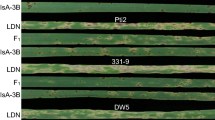Summary
Using disomic chromosome substitution lines based on the susceptible wheat cultivar ‘Chinese Spring’, loose smut resistance of wheat cultivars ‘Hope’ and ‘Thatcher’ was shown to be conferred in each case by a single dominant major gene carried on chromosome 7 A (‘Hope’) or 7 B (‘Thatcher’). Partial resistance was determined by genes on an additional eight ‘Hope’ or seven ‘Thatcher’ chromosomes, and similarities were evident between the partial resistance genotypes of‘Hope’ and ‘Thatcher’. ‘Chinese Spring’ exhibited a mean infection value of approximately 50%, indicating a significant level of partial resistance, which was found to be due, in part, to genes on the homoeologous chromosome arms 1 As, 1 Es and 1 Ds, and to cytoplasmic genes. Substitution of the ‘Chinese Spring’ nucleus into the cytoplasm of Aegilops squarrosa, Ae. variabilis or Ae. mutica resulted in increased susceptibility to Ustilago tritici. Several alloplasmic lines of the resistant wheat cultivars ‘Selkirk’ and ‘Chris’ exhibited race-specific susceptibility to U. tritici.
Similar content being viewed by others
References
Daly JM (1972) The use of near-isogenic lines in biochemical studies of the resistance of wheat to stem rust. Phytopathology 62:392–400
Dhitaphichit P (1987) Studies on loose smut of barley and wheat. Doctoral thesis, National University of Ireland
Doling DA (1968) Effects of infection with Ustilago nuda and of seed size on the vigour of barley plants. Trans Br Mycol Soc 51:179–183
Gaskin TA, Schafer JF (1962) Some histological and genetic relationships of resistance of wheat to loose smut. Phytopathology 52:602–607
Gupta AK, Bajam KL, Grewal RK (1979) In vitro detection of resistance to loose smut and its relationship to polyphenols. In: Ramanujam S (ed) Proc 5th Int Wheat Genet Symp, New Delhi, pp 1098–1101
Johansen DA (1940) Plant microtechnique. McGraw-Hill, New York
Johnson R (1976) Development and use of some genetically controlled lines for studies of host-parasite interactions. In: Friend J, Threllfall DR (eds) Biochemical aspects of plantparasite interactions. Academic Press, London New York San Francisco, pp 25–41
Keane EM (1989) Effects of cytoplasmic substitution on agronomic traits of wheat. Doctoral thesis, National University of Ireland
Király Z, Lelley J (1957) Hypersensitive reaction of wheat to loose smut infection. Rev Appl Mycol 38:738
Kleijer G, Fossati A, Paccaud FX (1980) Genetic analysis of tolerance to Septoria nodorum Berk in wheat using chromosome substitution lines. Z Pflanzenzuecht 85:287–293
Law CN (1967) The location of genetic factors controlling a number of quantitative characters in wheat. Genetics 56:445–461
Loegering WQ, Harmon DL (1969) Wheat lines near-isogenic for reaction to Puccinia graminis tritici. Phytopathology 59:456–459
Mantle PG (1961) Further observations on an abnormal reaction of wheat to loose smut. Trans Br Mycol Soc 44:529–545
Michalikova A (1970) The influence of stigma extracts of individual varieties of wheat in the germination of chlamydospores of Ustilago tritici (Pers.) Jens. Pol'nohospodarstve 16:19–23
Moore MB (1936) A method for inoculating wheat and barley with loose smuts. Phytopathology 26:397–400
Nielsen J (1969) A race of Ustilago tritici virulent on ‘Thatcher’ wheat and its derivatives. Plant Dis Rep 53:393–395
Nielsen J (1987) Races of Ustilago tritici and techniques for their study. Can J Plant Pathol 9:91–105
Pink DAC (1982) Cytogenetic studies of disease resistance in wheat. Doctoral thesis, Birmingham University
Popp W (1951) Infection in seeds and seedlings of wheat and barley in relation to development of loose smut. Phytopathology 41:261–275
Saini RS, Arora YK, Wagle DS (1985) Soluble proteins and multiple forms of peroxidase in growing points of wheat plants in relation to their resistance to loose smut. Biochem Physiol Pflanzen 180:239–245
Shands RG (1946) An apparent linkage of resistance to loose smut and stem rust in barley. J Am Soc Agron 38:690–692
Shands HL, Schaller CW (1946) Response of spring barley varieties to floral loose smut inoculation. Phytopathology 36:534–548
Skoropad WP, Johnson LPV (1952) Inheritance of resistance to Ustilago nuda in barley. Can J Bot 30:525–536
Tikhomirov VT (1983) Genetics of resistance of wheat to loose smut. I. Analysis of the wheat loose smut interaction on the basis of Flor's gene-for-gene hypothesis. Genetika 19:295–303
Tsunewaki K (1988) Cytoplasmic variation in Triticum and Aegilops. In: Miller TE, Koebner RMD (eds) Proc 7th Int Wheat Genet Symp Cambridge, pp 53–62
Valle Ribeiro MAM do (1963) Investigations into the pathogenicity of certain races of Ustilago nuda. Trans Br Mycol Soc 46:49–62
Washington WJ, Maan SS (1974) Disease reaction of wheat with alien cytoplasms. Crop Sci 14:903–904
Wells SA, Platt AW (1949) The effect of loose smut on the viability of artificially inoculated barley seeds. Sci Agr 29:45–52
Worland AJ, Gale MD, Law CN (1987) Wheat genetics. In: Lupton FGH (ed.) Wheat breeding: Its scientific basis. Chapman and Hall, London New York, pp 129–171
Author information
Authors and Affiliations
Additional information
Communicated by K. Tsunewaki
Rights and permissions
About this article
Cite this article
Dhitaphichit, P., Jones, P. & Keane, E.M. Nuclear and cytoplasmic gene control of resistance to loose smut (Ustilago tritici (Pers.) Rostr.) in wheat (Triticum aestivum L.). Theoret. Appl. Genetics 78, 897–903 (1989). https://doi.org/10.1007/BF00266678
Received:
Accepted:
Issue Date:
DOI: https://doi.org/10.1007/BF00266678




